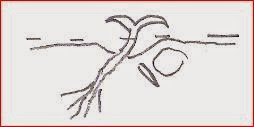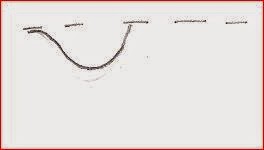 |
| Some Pre-sprouted Cucurbit Seed. |
 |
| A cucurbit seed with roots (left) and primary leaves (right) |
Cucurbitaceae or Cucurbit seed, including squash, cucumbers,
melons and their relatives tend to emerge from the seed coat in a uniform
fashion with the root emerging before the primary leaves. As the primary leaves
develop, they fill out until they can finally break free of the seed coat.
Depending on the seed quality and the environment provided, cucurbit seedlings
can require less than 1 day or over 2 weeks to emerge. Although seed quality is
not a factor that most gardeners have total control of, each gardener possesses
a large portion of control over a seedling’s initial environment.
In a previous post I outlined some tips for
exposing cucurbit seeds to an environment in which they will sprout. Once a
seedling is almost finished sprouting and its primary leaves begin to push off
their seed coat, a gardener can ensure that the seedling sprouts earlier by how
they position the seedling in the soil. Although various gardeners may find
different methods for getting their cucurbits off to a good start I wish to
show one method that I’ll call “seedling positioning” that I believe enables
seedlings to quickly expose their primary leaves to sunlight.
2. Then you make sure the soil you wish to plant in
has been watered deeply, then left to dry until the soil is workable (not
soaking).
3. Then, you dig one small trench.
4. Then another next to it.
5. Compact the dirt in between each trench to make
a bump or island between the two holes that can support the middle of the cucurbit
seed.
6. Then place the cucurbit seed with the root in
the soil at one side and the primary leaves and seed coat on the other side.
 |
| Drawing of seed placement or positioning |
 |
| Photograph of Seed Placement (or positioning) |
7. Fill in the root portion of the soil to the
soil line above the bump, leaving the middle of the seedling exposed.
8. Fill in the area above the primary leaves and
seed coat with soil to the soil line, compacting the soil or leaving a small rock
above the seed coat. By weighing down the seed coat the primary leaves will be
able to pull out of the seed coat without taking the seed coat with it.
 |
| Burying all but the midsection of the seedling. |
Note: 7 and 8 Can be interchanged. I actually prefer to fill in the seed coat first to hold the seedling in place.
 |
| Putting Dirt on the Seed Coat First |
9. Leave the middle of the seed exposed or gently
brush around where you last saw it until it is exposed.
10. Keep from directly watering on the seedling
(you can water near the seedling) until the seedling has sprouted.
 |
| With the seedling correctly placed in the soil it can sprout quickly. |
 |
| This time red arrows denote where the seeds are beginning to spout. |
 |
| In 1 day the sprouted seedlings have emerged because of their placement in the soil. |
Although I have not attempted
a side-by-side trail of using vs. not using my seedling positioning technique I
have noticed that positioning the seedlings so that they receive sun quickly
enables them to grow quickly. I hope that other gardeners are able to find that
positioning their seedlings helps them as much as it has helped me.
Happy Gardening!









































